
An intricate web of life lies beneath our feet that is often overlooked but plays a crucial role in shaping the health and fertility of our planet. Soil microbiology is of paramount importance in understanding the intricate relationships that exist between plants, soil, and the environment. The dynamic interplay of these microscopic organisms contributes significantly to soil fertility, nutrient cycling, plant growth, and overall ecosystem health.
So, why is soil microbiology so important and how does it impact sustainable agriculture?
A healthy soil teems with an astonishing diversity of microorganisms, including bacteria, fungi, protozoa, viruses, and archaea. As the saying goes, “One teaspoon of soil contains more living organisms than there are people on Earth”. These microorganisms interact with one another and their environment in complex ways, forming a symbiotic network known as the soil food web. Each plays a unique role, and their combined activities have far-reaching effects on the soil ecosystem.

Many of our soils are imbalanced, excessively acidic, and poorly aerated. Common management practices take everything out of our fields, including all crop residues. This leads to a poor environment which suppresses biological activity. When calcium, magnesium, and potassium levels are balanced, pH levels corrected, and organic matter increased, we can build up our soil biology, which will in turn unlock our soils so that the soil can feed our crops.
Bacteria and fungi break down complex organic matter, such as dead plant material and animal waste. This process releases and mineralizes plant nutrients such as nitrogen, phosphorus, and potassium, into simpler forms that can be readily absorbed by plants. Without the microbial decomposers, organic matter accumulates, and nutrients remain unavailable to plants and crops. Unlocking this soil life can reduce our fertilizer rates resulting in cost savings while improving our quantity and quality of yield.
Certain microorganisms establish symbiotic relationships with plants, forming mutually beneficial partnerships. A prime example is the mycorrhizal fungi forming intricate networks around plant roots, extending the plant’s effective root superficial area, and extending its reach for nutrients and water in exchange for carbohydrates produced by the plant through photosynthesis. This symbiosis enhances nutrient uptake, improving plant resilience to stress, leading to healthier and more productive crops.

Increasing the biological diversity of the soil allows us to control soil-borne disease pathogens from dominating the soil environment by direct competition for food sources. Some bacteria and fungi are natural antagonists of plant pathogens. This biological control can reduce the reliance on synthetic pesticides, promoting sustainable agricultural practices and minimising the ecological impact of chemical interventions. One of the impacts of chemical interventions is the destruction of microbiological life itself. The use of fungicides in the control of downy mildew for example, not only suppresses the harmful fungi, it also destroys the beneficial fungi, compromising the health of the soil.
Bacteria produce a sticky substance called exopolysaccharides, fungal hyphae and spores of mycorrhizal fungi produce glomalin, a glycoprotein which acts as a natural glue. All these exudates help bind soil particles together, forming stable aggregates, the basis of good soil structure. Soil structure is essential for creating a network of interconnected pores – i.e. improving porosity – that enhance water infiltration, water holding capacity, root penetration, air movement, and nutrient retention. Good soil structure ensures optimal conditions for plant growth and reduces the risk of soil compaction and loss of fertility through erosion.
Furthermore, fungal hyphae create a vast network that enhances soil structure and increases its ability to store carbon. For every 1% organic matter that you build up in your soils, you can hold approximately 48 cubes more water for your crop, greatly reducing irrigation and whilst greatly increasing crop tolerance to drought.

Understanding the importance of soil microbiology is crucial for promoting sustainable agricultural practices. We can advise you on how to harness the power of beneficial microorganisms, through the adoption of techniques such as cover cropping, crop rotation, and composting to balance your soils, enhance soil health and fertility. These practices promote biodiversity, reduce soil erosion, conserve water, and minimise the need for synthetic inputs, ultimately leading to more resilient and productive farming systems.
We can advise you on how to “turn your soil on”. Building healthy soil through the adoption of our biological farming system approach will reduce your reliance on increasingly expensive inputs and result in a highly sustainable and profitable farming operation producing higher quality, nutrient dense products. These offer better nutrition for consumers allowing growers to demand better prices.
Soil microbiology is a fascinating realm that holds the key to sustainable agriculture and ecosystem health. The intricate interactions between microorganisms and their environment influence soil fertility, nutrient cycling, disease suppression, and carbon sequestration. By acknowledging and harnessing the power of soil microbiology, we can pave the way for environmentally friendly agricultural practices that nourish both our planet and future generations.
In our next newsletter, we will share our exciting new range of soil health tests, and how we use this information to “future-proof” your farm!
Till next time
Order our services and get to know how to improve your soil for better yeilds.